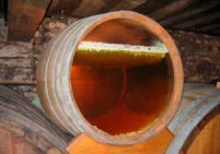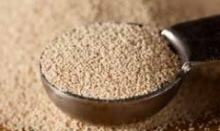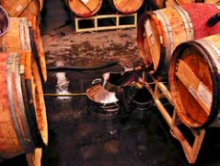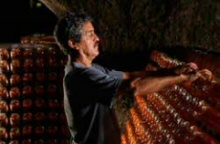|
 Racking is a wine making term that gets tossed out often and may sound like some complex process. But, in fact, the underlying basis of it is not so complicated. Racking is a method in wine production of moving wine from one holding container to another in order to filter the wine. The traditional method of doing it is to use the power of gravity to siphon the wine from one barrel or tank to another, so the required equipment isn’t even too sophisticated. Racking is a wine making term that gets tossed out often and may sound like some complex process. But, in fact, the underlying basis of it is not so complicated. Racking is a method in wine production of moving wine from one holding container to another in order to filter the wine. The traditional method of doing it is to use the power of gravity to siphon the wine from one barrel or tank to another, so the required equipment isn’t even too sophisticated.
The French term for racking is soutirage or soutirage traditionnel. This method was first developed in the Bordeaux region long before electricity and powered pumps. High quality wine production still uses the no-power, gravity approach. Although it is a labor-intensive process, most wine makers will agree that pumping wine with an electric pump during this important time in the wine’s development can be disruptive and result in damaging the flavor profile of a wine.
 The reasons to rack are to clarify the wine and to prevent off-flavors from developing. Off-flavors may develop from decomposing yeast, which is added to the wine to aid in fermentation. During fermentation, yeast cells convert the sugar in the grape must into alcohol and when the sugar food source for the yeast runs out, the yeast cells die and sink to the bottom of the fermentation vessel. The reasons to rack are to clarify the wine and to prevent off-flavors from developing. Off-flavors may develop from decomposing yeast, which is added to the wine to aid in fermentation. During fermentation, yeast cells convert the sugar in the grape must into alcohol and when the sugar food source for the yeast runs out, the yeast cells die and sink to the bottom of the fermentation vessel.
These dead yeast cells, called “lees”, cause cloudiness in wine. Racking will remove this cloudiness as the liquid is transferred from one container to another and the solid particles remain settled at the bottom of the first container. Wine makers are careful not to overrack, as too much movement can be harmful to the wine as each move introduces more oxygen to the wine. Too much exposure to oxygen at this time in the process can destroy a wine. Additionally, fining agents can be added to the wine in order to bond to the lees and assist in clarification instead of repeated rackings.
 Generally, racking occurs after initial fermentation has completed and the first racking removes the gross lees – the majority of the lees which will “fall out” during the winemaking process. Once this phase in the process is over, the wine is “racked off of the lees” and the fermentation process proceeds at a much slower pace. Some wine makers will only rack once and others will do it numerous times. How much racking is done will impact a flavor profile and clarity structure, so it allows the wine makers some flexibility in their wine designs. Generally, racking occurs after initial fermentation has completed and the first racking removes the gross lees – the majority of the lees which will “fall out” during the winemaking process. Once this phase in the process is over, the wine is “racked off of the lees” and the fermentation process proceeds at a much slower pace. Some wine makers will only rack once and others will do it numerous times. How much racking is done will impact a flavor profile and clarity structure, so it allows the wine makers some flexibility in their wine designs.
But…there are times when winemakers don’t want to remove the lees right away, and instead want their wine to age for a time with the dead yeast cells. This “aging on the lees”, as it’s called, is known as sur lie aging. You’ll see this at times noted on Chardonnay and Sparkling Wine bottles, but if you do you’ll probably also note that this method seems to result in higher price tags. The reason for this is quite simply that sur lie aging is a difficult process and only the best winemakers can pull it off well. So, you’re paying for the extra added difficulty of making a particular wine.
 The reasons winemakers will use the sur lie process is to have an added distinctive yeasty aroma and taste to their wines. Toasty, nutty, hazelnut…all are aroma profiles which can result from sur lie aging. The sur lie aging process also adds depth and complexity to wines, giving a creamy mouthfeel and fuller body. During the process, the lees may be stirred in order to impart even more characteristics from them. This process is called bâttonage. The reasons winemakers will use the sur lie process is to have an added distinctive yeasty aroma and taste to their wines. Toasty, nutty, hazelnut…all are aroma profiles which can result from sur lie aging. The sur lie aging process also adds depth and complexity to wines, giving a creamy mouthfeel and fuller body. During the process, the lees may be stirred in order to impart even more characteristics from them. This process is called bâttonage.
Hopefully now your wine vocabulary has been fortified and you’ll easily recognize these terms associated with racking wines and aging on the lees.
|

 Racking is a wine making term that gets tossed out often and may sound like some complex process. But, in fact, the underlying basis of it is not so complicated. Racking is a method in wine production of moving wine from one holding container to another in order to filter the wine. The traditional method of doing it is to use the power of gravity to siphon the wine from one barrel or tank to another, so the required equipment isn’t even too sophisticated.
Racking is a wine making term that gets tossed out often and may sound like some complex process. But, in fact, the underlying basis of it is not so complicated. Racking is a method in wine production of moving wine from one holding container to another in order to filter the wine. The traditional method of doing it is to use the power of gravity to siphon the wine from one barrel or tank to another, so the required equipment isn’t even too sophisticated. The reasons to rack are to clarify the wine and to prevent off-flavors from developing. Off-flavors may develop from decomposing yeast, which is added to the wine to aid in fermentation. During fermentation, yeast cells convert the sugar in the grape must into alcohol and when the sugar food source for the yeast runs out, the yeast cells die and sink to the bottom of the fermentation vessel.
The reasons to rack are to clarify the wine and to prevent off-flavors from developing. Off-flavors may develop from decomposing yeast, which is added to the wine to aid in fermentation. During fermentation, yeast cells convert the sugar in the grape must into alcohol and when the sugar food source for the yeast runs out, the yeast cells die and sink to the bottom of the fermentation vessel. Generally, racking occurs after initial fermentation has completed and the first racking removes the gross lees – the majority of the lees which will “fall out” during the winemaking process. Once this phase in the process is over, the wine is “racked off of the lees” and the fermentation process proceeds at a much slower pace. Some wine makers will only rack once and others will do it numerous times. How much racking is done will impact a flavor profile and clarity structure, so it allows the wine makers some flexibility in their wine designs.
Generally, racking occurs after initial fermentation has completed and the first racking removes the gross lees – the majority of the lees which will “fall out” during the winemaking process. Once this phase in the process is over, the wine is “racked off of the lees” and the fermentation process proceeds at a much slower pace. Some wine makers will only rack once and others will do it numerous times. How much racking is done will impact a flavor profile and clarity structure, so it allows the wine makers some flexibility in their wine designs. The reasons winemakers will use the sur lie process is to have an added distinctive yeasty aroma and taste to their wines. Toasty, nutty, hazelnut…all are aroma profiles which can result from sur lie aging. The sur lie aging process also adds depth and complexity to wines, giving a creamy mouthfeel and fuller body. During the process, the lees may be stirred in order to impart even more characteristics from them. This process is called bâttonage.
The reasons winemakers will use the sur lie process is to have an added distinctive yeasty aroma and taste to their wines. Toasty, nutty, hazelnut…all are aroma profiles which can result from sur lie aging. The sur lie aging process also adds depth and complexity to wines, giving a creamy mouthfeel and fuller body. During the process, the lees may be stirred in order to impart even more characteristics from them. This process is called bâttonage.